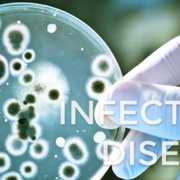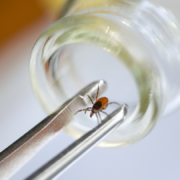What Is Post-Treatment Lyme Disease Syndrome?
Life After Lyme
You’ll never forget that summer. You spent every weekend outdoors gardening, hiking in the woods with your dog, and camping with friends. It was a magical nature-rich season—until the end when you got really sick. Living in deer tick country, you knew to take certain precautions and were thorough about checking for ticks after each glorious outing. One teeny tiny tick must have escaped your check.
You felt pretty crummy for a bit, received a positive Lyme disease diagnosis (a lucky catch, as more than 50% of cases receive a false-negative result), took the typically prescribed series of antibiotics, and thought to yourself after, “well, I’m glad that’s over now.” Why then do you still feel awful sometimes for no apparent reason? Post-treatment Lyme disease syndrome (PTLDS) might be to blame.
Why Do Lyme Symptoms Linger?
As you know, Lyme disease is caused by the bacterium Borrelia burgdorferi. The conventional approach to eradicating Lyme disease is to eliminate the bacteria, which is why a long series of antibiotics is the standard treatment. But B. burgdorferi is a tricky bugger and one that can continue to wreak havoc long after it has physically been eradicated from your system.
The persistent neurocognitive symptoms that can manifest from PTLDS can include (but are not limited to) chronic fatigue, musculoskeletal pain, mood or behavioral changes, disrupted sleep patterns, memory loss, dizziness, and headaches. A common consistency among those suffering from PTLDS (whether it is realized or not that PTLDS is the culprit) is that symptoms tend to wax and wane. This, of course, makes PTLDS very frustrating, and as a result, can greatly impact the quality of your life and your ability to shine in all aspects of your life (i.e., work, relationships, personal goals, etc.).
What Causes Post-Treatment Lyme Disease?
There are several different possible explanations as to what causes PTLDS, but the reason for recurring Lyme disease is still not fully understood by the medical community. Known as “the Great Imitator,” Lyme disease can act like a lot of different chronic conditions, which is one reason there is such a high rate of misdiagnosis. The physical and emotional stress of enduring symptoms and even a false diagnosis of multiple sclerosis, amyotrophic lateral sclerosis, rheumatoid arthritis, fibromyalgia, lupus, depression, or Alzheimer’s disease is not only traumatic but incredibly taxing on your limbic and immune system.
A weakened immune system and dysregulated limbic system (responsible for fight-or-flight response) perpetuate symptoms of PTLDS. It is also the lingering responses from the immune system after the bacteria has been eradicated that are believed to play a key role in chronic symptoms associated with PTLDS.
Another school of thought relates to the consequences of heavy use of antibiotics. While antibiotics are sometimes effective at wiping out the bad bacteria, they are also indiscriminate and negatively affect all the good bacteria in your body. One of the major shortcomings of antibiotics is the destruction of the gut microbiome. Gut health is directly related to immune health, and poor gut health can leave you vulnerable to additional bacterial, viral, and fungal infections.
Interestingly, while antibiotics are the most common prescription for treating Lyme disease, they don’t always work, and in fact, a lot of time don’t provide that quick cure we all hope to receive. The good news is there are alternative approaches to treating Lyme disease from the get-go, as well as holistic therapies to support a more effective healing and recovery environment.
It is possible, though, that PTLDS is the result of all of the above—sustained fight-or-flight mode, compromised gut microbiome flora as a result of antibiotics, conditioned immune suppression, and the toxic and traumatic burden of enduring subjective and seemingly unexplainable symptoms.
What to Do When Symptoms Flare-Up
It is totally understandable to feel angry, defeated, depleted, confused, frustrated, and hopeless when symptoms flare up after a bout of feeling fine or even great. But succumbing to these conditioned emotional responses only further strengthens the negative feedback loop. And remember, there is a direct connection between our emotional self and our physical self. Overcoming PTLDS is about breaking the negative feedback loop by recognizing patterns and taking control over what you have control of.
The next time you shift from a symptom-free (or subtle symptoms) to symptomatic state:
Take a pause
While your initial response might be to allow the flood gates of emotions to open, “Why is this happening to me? I should just give up. I will never get better.”, try instead to take a deep breath, recognize what is happening, and press the pause button. Allow yourself to simply acknowledge how you are feeling instead of reacting to how you are feeling.
Pay attention to your environment
When you feel depressed, foggy, headachy, in pain, or wiped out, take notice of what is happening around you. What is going on in your life? Are you overextending yourself, working too much, neglecting your nutritional needs, spending too much time indoors, not sleeping enough or too much? Is there an external factor that is triggering an emotional response? Are you stressed?
Take notes
Try keeping a journal to keep track of both good and bad days. What are you feeling? What is going on around you? Any notes or observations you can make might help you eventually identify a pattern.
Work toward identifying a pattern
You might find that there is a pattern to when and why you feel a certain way. Identifying a pattern can help you create a new pattern, one that is conducive to healing.

Is PTLDS Really a Set Back? Or Just Part of the Healing Process?
Our bodies were designed to self-heal. But this can only occur when our natural healing processes are supported. The first step to healing, though, is shifting your perspective. You must believe that you can overcome PTLDS and that healing takes time and is a journey. In fact, it is even possible to learn to embrace and enjoy the healing process.
This might include learning about and trying new therapies to aid you in your recovery, such as Emotional Freedom Technique (EFT), Neuro emotional technique (NET), and ACMOS. Nutrition is another key factor in healing and health. Eating to support your immune function can also be something from which you harvest joy. Your diet is also something that you can control.
If you can calm your nervous system, fuel your immunity through detox and diet, eliminate triggers, open your mind to alternative therapies, and write yourself in as the hero of your healing journey, you will find that there is a light at the end of the Lyme tunnel.
See how we can help you restore complete health of body, mind & spirit.
Join our mailing list and receive exclusive offers + information!







Leave a Reply
Want to join the discussion?Feel free to contribute!